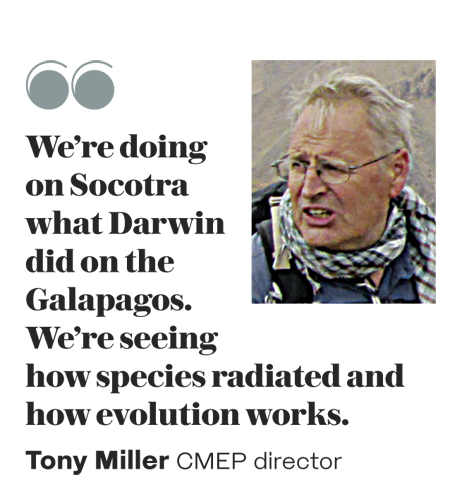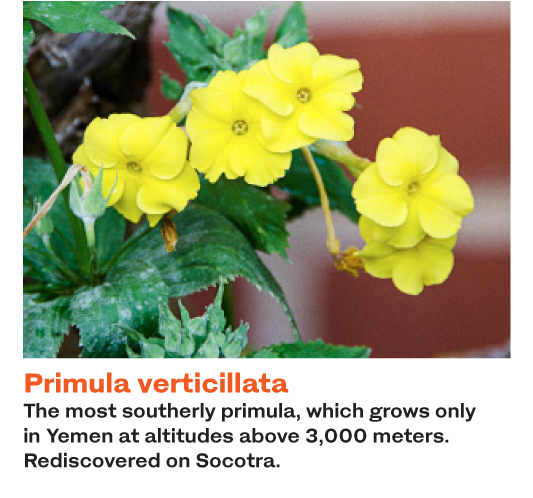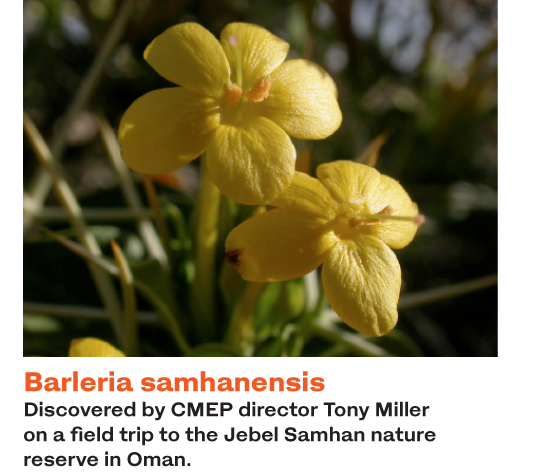EDINBURGH, UK: The Arabian Peninsula is rich in many things — oil (obviously), literature, history, cuisine. But far away in Edinburgh is a treasure trove of other Middle Eastern riches — plants.
The Scottish capital is home to the Center for Middle Eastern Plants (CMEP) and a herbarium — or plant library — containing a staggering 3 million samples of flora from the region. And botanists from the center are still adding to the collection.
 “There is a mountain in Oman called Jebel Samhan and every time I’ve gone up it I’ve discovered a new species,” said CMEP director Tony Miller, who has been making field trips to Yemen, Oman, Iran and Saudi Arabia since 1978.
“There is a mountain in Oman called Jebel Samhan and every time I’ve gone up it I’ve discovered a new species,” said CMEP director Tony Miller, who has been making field trips to Yemen, Oman, Iran and Saudi Arabia since 1978.
“The last time I took visitors up there I wondered if I had set myself up for embarrassment but no, pretty much as soon as I stepped out of the vehicle, I spotted a completely new plant right in front of me.”
Socotra, the island off the coast of Yemen in the Arabian Sea, is especially important for the study of flora.
“Socotra is the Galapagos of the Indian Ocean,” said Miller.
“It has 900 plants of which more than 300 are endemic — that is, they are unique to that place. In comparison, the number of plants endemic to Britain is a handful. Every single tree on Socotra is endemic. The place is a vast biosphere reserve.
“We’re doing on Socotra what Darwin did on the Galapagos. We’re seeing how species radiated and how evolution works.”
Heady stuff for those who are passionate about plants. But how did a center for studying and documenting the plant life of the world’s most arid landscapes come to be established in an all-too-often grey and rainy Edinburgh?
That is down to a decision taken more than 50 years ago. CMEP is part of Edinburgh’s Royal Botanic Garden, which is itself a sister to the Royal Botanical Gardens at Kew in London.
In 1962, it was decided to divide the areas of study. Kew got Africa, while Edinburgh got China, the Himalayas and southwest Asia, which includes the Arabian Peninsula. Europe, Central and North America went to the Natural History Museum in London.
CMEP’s offices are unremarkable: Plain desks and bookshelves heaving with tomes such as “Flora of the Arabian Peninsula and Socotra” (co-authored by Tony Miller) and “Ethnoflora of the Socotra Archipelago” (co-written with Miranda Morris), which not only lists the flora of the Yemeni island but also explains what each plant was for.
It is the herbarium that reveals CMEP’s purpose. Instead of books there are shelves full of folders containing dried specimens of flowers, grasses, leaves and roots. Each folder has a little envelope stuck in the bottom corner for storing any bits of the plant sample that might fall off.
Few hobby gardeners know that some of the best-loved blooms found in a typical Western flowerbed originated in southwest Asia — tulips, fritillaries, muscari (commonly known as grape hyacinths), to name only a few.
The first plants to be cultivated were wheat, barley, flax, peas, chickpeas, lentils and bitter vetch. Collectively known as the Neolithic founder plants, they all originated in the marshes of Sumeria in what is present-day Iraq. Their cultivation led to agriculture and settled habitation in villages and then towns which in turn led to the development of an alphabet, writing and laws.
 Then there is aloe vera, well-known for its medicinal properties. Pale-skinned holidaymakers in Dubai little realize that the gel they are slapping on their sunburn originally came from Yemen.
Then there is aloe vera, well-known for its medicinal properties. Pale-skinned holidaymakers in Dubai little realize that the gel they are slapping on their sunburn originally came from Yemen.
One variety of aloe was recently rediscovered in Al-Ula, in Saudi Arabia. The only other place it grows north of the Tropic of Cancer is Petra in Jordan. Its presence in both places is compelling evidence of the contact between those two ancient Nabataean sites and societies much further south.
CMEP was set up as a separate entity in 2009 to generate income from consultancy work which could then be ploughed into conservation and training projects. There are four full-time staff with PhD students or fellows on temporary attachments.
Classifying and documenting plants — a discipline known as taxonomy — is an important part of CMEP’s work. “After all, you can’t conserve it if you don’t know what it is,” said Miller. But the projects also have a strong social component.
In Bamyan province in Afghanistan, that meant helping the environment by distributing cooking stoves to people in remote communities.
“There are no trees left in Bamyan. People cook on open fires, and all the trees and shrubs have been cut down for firewood. Now they are pulling up shrubs and roots and burning them, which is not healthy,” said Miller.
“According to the World Health Organization, 54,000 people a year are dying of pulmonary disease caused by indoor pollution. No trees means there is nothing to anchor the soil which leads to water and mudslides. With the stoves, they are still burning wood, but it burns more efficiently and lasts longer and so they need less of it.”
 The Bamyan inhabitants were not immediately convinced. In the first year, they collected the same amount of firewood as always, especially when hoarding for winter, which requires collecting two to three donkey loads every day for a week.
The Bamyan inhabitants were not immediately convinced. In the first year, they collected the same amount of firewood as always, especially when hoarding for winter, which requires collecting two to three donkey loads every day for a week.
“But they soon noticed the difference and collected less the next year,” said Dr. Sophie Neale, another member of the CMEP team.
Restoring landscapes involves more than simply shoving plants into the ground.
“When you talk about restoration, how far back do you go? Back to grandfather’s day? Back to how the land was before humans? How do you adapt the old ways to modern life? It’s a philosophical question,” said Miller. “We finally settled on restoration to a time before rapid development.”
Then there is the perception of botany itself. The great 19th-century plant-hunters roamed the world’s unexplored habitats collecting specimens. They were certainly intrepid, but many also had the time and often the backing of a wealthy aristocratic patron, and it is true to say that — somewhat unfairly —botany retains some of that “rich man’s hobby” image.
Is it difficult to persuade young people in the business-driven Middle East that studying plants is worthwhile?
“A little, but there is a growing awareness of it as a profession,”
said Miller.
CMEP runs online courses that are not only popular but also a good way of spotting new talent.
“If they stick with the course, it shows they’re dedicated as well as good,” said Miller. Studying plants attracts both men and women; a class in Oman has 40 women and one man, and the current CMEP fellows include an Afghan woman and a Lebanese woman.
 Earlier this year, Miller and his team won an award at the International Workshop on Combating Desertification in Saudi Arabia for work on “greening” Riyadh.
Earlier this year, Miller and his team won an award at the International Workshop on Combating Desertification in Saudi Arabia for work on “greening” Riyadh.
There is a marked trend in Saudi Arabia away from using plants that need lots of irrigation, but knowledge about what should be planted in their place can be limited.
“They want to use native species, but unfortunately they don’t know where they grow, so it ends up being easier to just go down to the garden center,” said Miller.
“The problem in Riyadh is … goats and camels dig up roots, so plants have no chance.”
An experiment carried out in Kuwait illustrates nature’s infinite capacity for self-healing. Researchers fenced off an area of land to keep animals away and then simply waited to see what would happen. By the following year, plants growing there again. After another year, what had been an expanse of arid, barren land was alive with desert vegetation.
Miller, 67, has been at the Royal Botanic Garden in Edinburgh for
42 years and has been making expeditions to the Arabian Peninsula almost as long. Socotra, which he first visited in 1989, retains a special fascination.
“In Socotra, every tree is known. If you want to cut a tree down, you must get permission from the community. It means every tree has a value and everyone knows which tree belongs to which village. The Mediterranean used to be covered in dragon blood trees once. Socotra still has them.”
Among CMEP’s other projects are building botanic gardens in Kabul and in Sulaymaniyah, in Iraqi Kurdistan.
“It’s what called soft diplomacy,” said Miller. Which, when one thinks about it, makes sense. For who in the world could ever object to a garden?




















